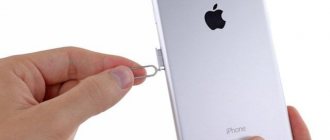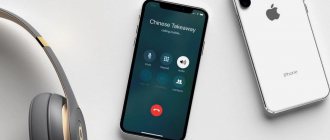Good time everyone! Why is there the phrase “don’t rush to service” in the title of the article? It's simple - sometimes self-rebooting your iPhone can be fixed at home. I will say more - in some cases, this does not indicate any deviations in his work at all.
Yes, this really happens - the iPhone restarted... and this is the norm! © Elena Malysheva.
Suddenly? It's only the beginning! However, let's not get ahead of ourselves - after all, the options can be very different... Better let's talk about everything in order. One two Three. Let's go quickly and decisively!
Why does my iPhone keep rebooting?
If your iPhone restarts on its own, there are several possible explanations:
- Software requires updating;
- problematic firmware installed;
- device memory is full;
- date and time settings are lost;
- Incompatible applications are installed;
- SIM card is not installed correctly;
- The battery or other parts of the gadget are damaged.
If the reason is unclear to you, try to fix the software glitches yourself. If all else fails, or you don’t have time, contact a specialist.
When is it normal to reboot an iPhone on its own?
When this situation does not occur on an ongoing basis. Let me explain with a simple example:
- You bought an iPhone.
- You use it for several weeks (months, years).
- It suddenly picked up and unexpectedly rebooted.
- After that, the phone turned on and continued to work as if nothing had happened.
So, this is a completely normal situation.
Author's personal experience
Every iPhone I've used has rebooted on its own at least once or twice (during the entire time I've owned it).
Why? Don't know. Most likely, this situation is explained by “glitches” and failures in iOS. And again, iOS is a smart system. Therefore, he can reboot once and thereby “cleanse his brain.” Why not?
Conclusion: Rebooting the iPhone once on its own (over a long period of use) is quite the norm. What to do about it? Resign yourself - this happens to almost everyone.
iPhone keeps rebooting: how to fix the problem yourself
As soon as you notice that the iPhone is rebooting itself, perform a force reboot. Press and hold the Power and Home buttons for a few seconds: release when the brand logo appears. The device will reboot, which will help resolve system errors.
Check to see if there are any software updates available. Apple recommends always installing the latest updates to minimize potential errors. If the reboot is associated with a system error, install a new version of your iPhone that does not have it.
The opposite situation is also possible: you installed a problematic firmware version. Read what they write about it on the forums: if the reviews are negative, roll back.
It happens that the phone is “in a loop” - it cannot change the date for which the system update was scheduled. Go to “Settings” → “Date and Time” and set any custom date. Check if the method worked, and then return the current number.
Make sure you have enough free space on your iPhone. Go to “Settings” → “General” → “About device” → “Available”. If there is almost no memory left, we recommend moving some of the files to the cloud. You also need to regularly clear the application cache through “Settings” → “Applications” → “Delete cache”.
If the problem occurs after installing an application from questionable sources, uninstall it. Find the icon on your desktop, press and hold for a few seconds until it is removed. Also try removing the SIM card and installing it again - sometimes this helps.
If all else fails
Today we looked at many ways to eliminate forced reboot of iPhone. If none of the above helps, we recommend that you seek help from our expert, who has answered the most common questions.
Hermann
Expert in the field of digital technologies and the activities of mobile operators. I am engaged in constant monitoring of industry changes in Russia and abroad.
Ask a Question
Question to the expert
How else can you try to solve the problem yourself?
As an alternative method, it is worth considering disabling various iPhone services. Try turning off geolocation, bluetooth or internet. This will help you understand what exactly is causing the reboot. It is also recommended to check the condition of the battery and, if necessary, calibrate it.
Why couldn't I fix the error?
Most likely, the problem lies not in the software, but in the hardware. That is, a reboot occurs due to wear and tear of some elements of the smartphone (RAM, ROM, processor, and so on).
How to fix a hardware problem?
It is recommended to contact a service center. And if the iPhone is under warranty, it is better to bring the smartphone to the place of purchase. This will give you a free diagnosis and repair or replace the device without any extra costs.
4.4/5 — (25 votes)
Repair at the service center
The problem may be due to battery wear. To check, go to “Settings” → “Battery” → “Battery Status” → “Maximum Capacity”. If it is less than 70-80% of the original, then it’s time to change the battery.
Spontaneous rebooting may indicate a malfunction:
- signal power amplifier;
- processor;
- power controllers;
- wireless communication modules.
Components could fail due to wear, mechanical damage, or moisture getting inside the case. You will not be able to replace them yourself - you need to contact the service.
Tenorshare ReiBoot application
Using the Tenorshare ReiBoot application, you can exit the cyclic reboot in iOS 12 and restart your phone:
- Download and install the Tenorshare ReiBoot application on your computer. We connect the gadget to the PC using a USB cable.
- If Tenorshare ReiBoot recognizes your device, click on the “Enter Recovery Mode” item and switch the gadget to the appropriate mode.
- After a few minutes, the Exit Recovery Mode icon will appear. Click on this button to solve the problem.
The free Tenorshare ReiBoot app is the most popular and is perfectly compatible with iOS 12. The utility solves problems with blue/black screen, overheating, freezing, cycling, stuck on logo and stuck in recovery mode.
Backup
When your iPhone constantly reboots, you need to immediately copy all important information from it. To do this, you can use numerous utilities or manually transfer documents and folders to the cloud or to a removable hard drive.
This is an important process, since in certain cases (when restoring factory settings or after a software update), information from the iPhone is permanently deleted. If after performing this operation the iPhone constantly reboots, you need to try other methods.
Reset
This method has some differences from the option of returning the smartphone to factory settings. To reset the settings and stabilize the operation of the gadget, you need to do a few simple manipulations. It is necessary to take into account that after this you need to reinstall the ringtone and so on.
We perform the following actions:
- Go to the general settings of the device. There we find the corresponding key.
- Click on “Reset all settings”, the device will reboot.
Although this method does not delete the personal information of the smartphone owner, it is better to play it safe once again and copy the most important files to a separate medium.
Qualified help
If you were unable to independently figure out the reasons for this iPhone behavior, you should take it to a service center for diagnostics. There you will be told the true cause and possible ways to eliminate it. Be prepared to pay a pretty penny to get your phone repaired.
If you don’t have free money right now that you could spend on repairing your gadget, you need to install the Cubux application. It was created for maintaining and recording home accounting. With Cubux, you can start spending your money wisely, as you will clearly see all the unnecessary purchases you have made.
Battery calibration as a method of dealing with jumping charge percentages
This is because errors do not always lie in the iOS version itself, but can be much deeper, at the level of the battery controller. And here you can’t get away with a simple flashing. But at the same time, this can be corrected - after all, there is a so-called battery calibration, designed precisely to correct the problem with incorrect display of charge percentages on the iPhone. How to make it?
- Completely discharge the device.
- Charge.
- Discharge again.
- And so on several times.
Of course, this is all a fairly shortened version and there are a lot of nuances that must be observed. There are already detailed instructions about all this - you can read it here.
True, calibration may not help restore normal charging indication. Why? But because the problem may be hidden even deeper...
The battery percentage on the iPhone jumps (jumps) - what can be done?
Hello everyone! The problem mentioned in the title is quite common and almost anyone who has owned an iPhone for more than one year has definitely encountered it. Or maybe less... Because sometimes the iPhone battery charging percentage starts to “jump” even after a regular update, of which there are quite a few in a year. In any case, whatever leads to such jumps in the charging indication, this phenomenon is abnormal and absolutely needs to be corrected. How? Now you will find out everything. Let's go! :)
But first, let’s define what kind of phenomenon this is – “the charge indication jumps”? This means that when you enable the display of your iPhone's battery charge percentage (there is such an option), these same percentages may be consumed out of order. What then?
For example, like this:
- Abruptly disappear several dozen in a couple of minutes. It was 30%, now it is 7%.
- It takes a long time to freeze at one value - you use it for two hours, and it’s still 70% and nothing has changed - an endless battery :)
- When connected to the power adapter, the percentages again jump, only upwards. Take a device with 2%, insert the charging cable, and instantly you already have 20%.
As you understand, with such abnormal charging behavior it is very difficult to use the device. Simply because you don’t understand how charged the iPhone really is? You look - it looks like there is half a charge and this should definitely be enough for four hours. And you leave the house and after 5 minutes it has already turned off. Has this ever happened? I have yes. Let's find out why this happens and how you can fight it.
Why can the charge percentage on an iPhone “jump”?
To begin with, let's briefly go over the main reasons that can lead to such a problem:
- The most popular are non-original chargers and cables. The use of such accessories has a very negative effect on the behavior of the battery. I understand that it is very difficult to completely abandon Chinese chargers and cables - I myself have one such uncertified Lighting cable just in case (I even told you how to properly charge your iPhone), but using them constantly is not recommended.
- Operation in low temperature conditions.
- The battery loses a lot of its physical capacity.
- Installation of non-original, and simply low-quality spare parts - in most cases, some wildly Chinese battery.
Of course, this is not all - there are also various “bugs” in the iOS system itself. I guess I’ll start with them...
Why it won't charge - possible problems
The most likely reasons why your iPhone won't charge when the charger is connected are problems with the charger or cable. It could also be due to software update errors.
Dirt that gets into the Lightning port or oxidation of its contacts may cause the charging process to not begin. A failed battery also causes the problem.
It happens that the iPhone, on the contrary, charges, but does not turn on. This is written in detail in the article:
Cleaning the device port
When the device reboots while connecting headphones or while charging, you must carefully remove the Lightning connector. It is possible that lint, dust or other debris has collected in the connector, resulting in poor electrical connections when the device is connected to the charger.
You can clean the port of the device using a toothpick, a small needle or a hairpin. Experts advise purchasing a special can of compressed air. It can be used to reliably clean a variety of equipment.
The cause of the problem may be the use of a non-native cord from the smartphone. In this situation, you need to purchase a higher quality wire from the official Apple store.
iPhone X(s/r)/8/7/6 reboots itself on iOS 12 periodically or cyclically5
Common reasons why a device may restart
If during operation the gadget’s screen turns off on its own, and then the cell phone begins to reboot, you need to find out the reasons. The iPhone turns off and reboots in the following cases:
- Firmware. If there is a glitch in the OS, this will affect the operation of the gadget. When the installed iOS does not work correctly, it leads to random system restarts. In this case, you will need to replace the firmware.
- Battery. When using a smartphone for a long time, the battery may drain faster as its capacity decreases. The battery can function fully for one year. After 1.5-2 years, the user will notice that the gadget shrinks faster. Spontaneous reboots may also occur.
- Exploitation. As the company's research shows, you can use the phone at temperatures from 0 to +35 degrees. If the temperature readings are higher or lower, the display may turn off. It is not recommended to overcool the gadget or overheat it.
- Applications. A problem with system restart may occur if the user has installed a third-party application. When the software and iOS program do not match, a system crash may occur. Then the smartphone independently restarts the software to restore its operation.
- Device malfunction. When the owner cannot determine the cause, he needs to contact an Apple technical center. Employees will diagnose the smartphone and solve the problem. It is possible that an independent restart occurs due to a malfunction of the motherboard. When the problem is in the details of the gadget, the employee will be able to change it.
- note
- If the owner notices that the cell phone has started to freeze, it is also recommended to determine the cause of this failure. When the cause is eliminated, there will be no more freezes. The cell phone will start working normally.
Updating or uninstalling apps
Sudden gadget reboots can begin immediately after a popular instant messenger or a new utility has been installed. In this situation, the problem may be that it is not the phone itself that is trying to update, but a specific program or game.
In this situation, you need to carefully study all programs. If possible, reinstall them. Many people do not want to delete their own achievements in games, so applications can be updated to the latest versions offered by the manufacturer.
Doesn't charge after 80%
It may happen that the iPhone does not charge after reaching 80% battery level. This happens for two reasons:
- First, the operating system monitors the temperature while charging. When the battery heat reaches its limit, the process stops and can resume after the iPhone cools down. To quickly resume the process, the iPhone with the network adapter should be moved to a cold place. This feature is driven by the need to control the temperature of the battery to prevent damage or even explosion. As you know, lithium batteries used in iPhones, along with their high capacity, are fire hazards.
- Secondly, the charging process is stopped to increase battery life. This feature is called optimized charging. It is available on devices running iOS 13 or a newer version of the operating system.











